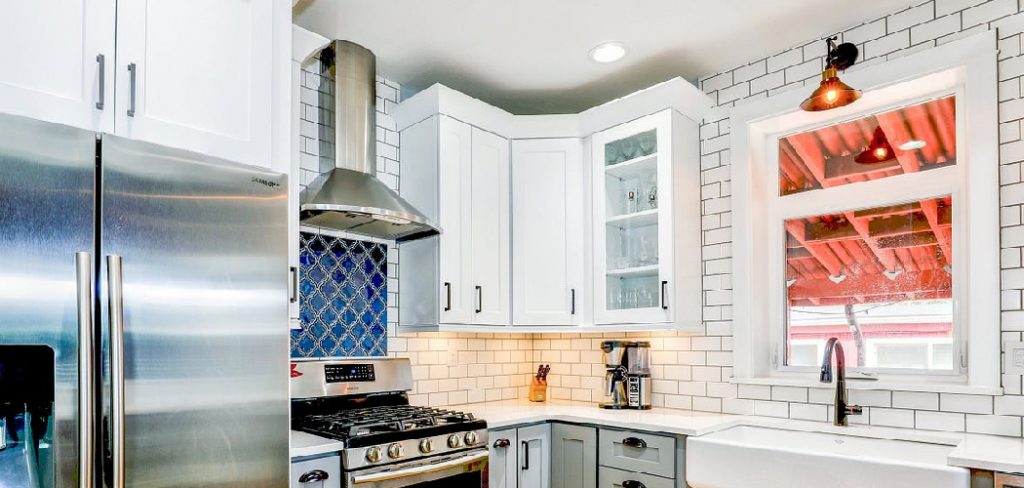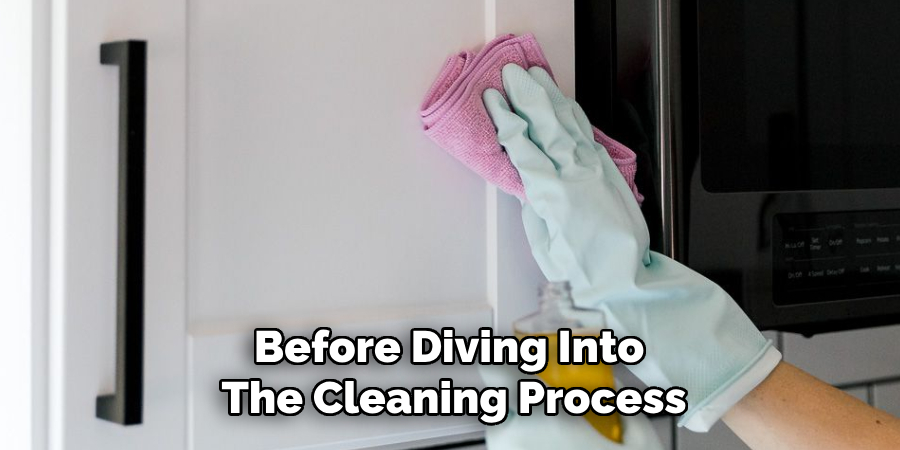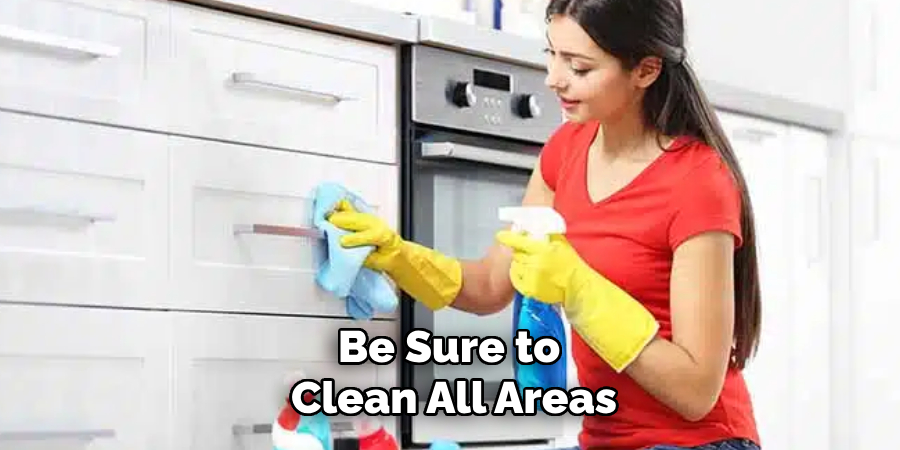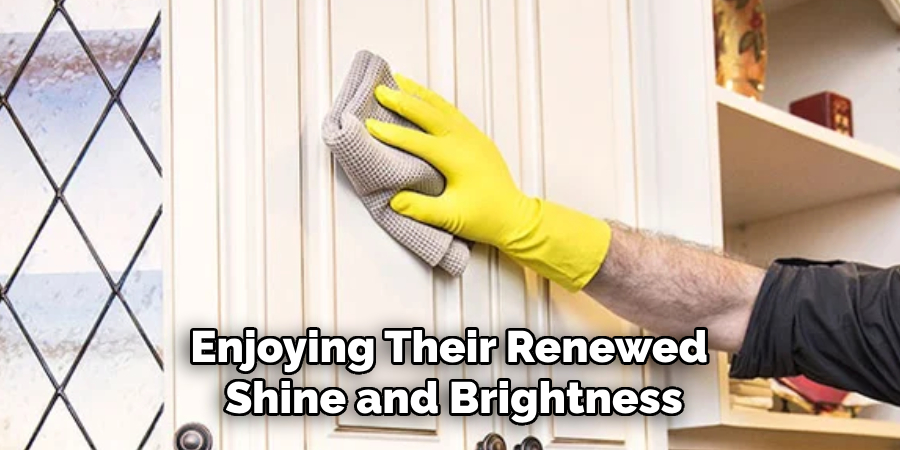Cleaning white cabinets can significantly enhance the overall appearance of your kitchen or bathroom, making it look fresh and inviting. Over time, white surfaces can accumulate stains, grease, and dust, which can dull their brightness and charm.

In this guide on how to clean white cabinets, we will explore effective methods and tips for maintaining the pristine condition of your white cabinets, ensuring they remain a stunning focal point in your home. Whether you are dealing with laminate, wood, or painted finishes, our straightforward cleaning techniques will help you achieve a gleaming result without the hassle.
Why White Cabinets Require Special Attention?
White cabinets, while admired for their crisp and clean aesthetic, require special attention due to their tendency to show imperfections more readily than darker finishes. Stains, fingerprints, and grease can easily mar their surface, making regular maintenance essential to preserve their appeal. Additionally, the lighter color can highlight even minor scratches or scuffs, necessitating prompt cleaning and care to prevent further damage.
Environmental factors, such as sunlight, can also cause yellowing or fading over time, making it crucial to use appropriate cleaning products that are both effective and safe for the material. By dedicating time and effort to the upkeep of white cabinets, homeowners can ensure that these stunning features continue to elevate the beauty of their space.
Needed Materials
Before diving into the cleaning process, it is essential to gather all the necessary materials. Here are some of the items you will need:
Microfiber Cloth or Soft Sponge
A microfiber cloth or soft sponge is gentle enough to clean white cabinets without scratching the surface and can also effectively remove dirt and grime.
Mild Dish Soap:
Mild dish soap mixed with warm water is an effective and safe cleaning solution for most types of white cabinets. Ensure that the dish soap does not contain any harsh chemicals that can damage the finish.
White Vinegar:
White vinegar is a natural disinfectant that can help remove tough stains, grease, and build-up on white cabinets while imparting a shine.
Baking Soda:
Baking soda is a versatile household ingredient that acts as an excellent abrasive cleaner for tougher stains, such as scuff marks or stubborn grease.
Lemon or Orange Essential Oil
Citrus essential oils not only leave a refreshing scent but also possess natural cleaning properties that can help cut through grease and grime on white cabinets.

7 Step-by-step Guidelines on How to Clean White Cabinets
Step 1: Remove Items from Cabinets
Before beginning the cleaning process, it’s crucial to clear out your cabinets. Start by removing all items, including dishes, food, and any other contents stored within the cabinets. This will provide you with unobstructed access to the surfaces that need cleaning and help prevent any accidental damage to your belongings.
Take this opportunity to sort through the items, discarding anything that is expired or no longer needed, which can contribute to a clutter-free and organized space. Once the cabinets are empty, proceed to dust off the shelves and interiors to remove loose debris before tackling the surfaces.
Step 2: Spot Test Cleaning Solutions
Before applying any cleaning solution to your white cabinets, it’s essential to spot-test a small, inconspicuous area first. This will help determine if the product is safe and suitable for your specific cabinet material and finish. Additionally, it can also reveal any potential adverse reactions or discoloration that may occur.
To spot test, apply a small amount of the chosen cleaner on an unnoticeable area and let it sit for a few minutes before wiping it off with a damp cloth. If there are no negative effects, proceed with using the chosen cleaning method.
Step 3: Wipe Down Surfaces with Mild Dish Soap Solution
Mix a few drops of mild dish soap with warm water in a container or spray bottle. Dip a microfiber cloth or soft sponge into the solution, wring out excess water, and gently wipe down the surfaces of your white cabinets. Avoid using too much water to prevent any damage to the wood or laminate finishes.
Be sure to clean all areas, including cabinet doors, handles, and frames. For tougher stains or stubborn grime, allow the cleaning solution to sit for a few minutes before wiping it off with a damp cloth.
Step 4: Remove Tough Stains with White Vinegar or Baking Soda
For tougher stains or build-up, mix equal parts of white vinegar and warm water in a spray bottle. Spray the solution onto the affected area and let it sit for a few minutes before gently wiping it off with a microfiber cloth. For stubborn stains, create a paste using baking soda and water, apply it to the stain, and let it sit for 10-15 minutes before gently scrubbing and wiping away.

The acidic properties of white vinegar and the abrasive action of baking soda can help remove tough stains, leaving your white cabinets looking pristine.
Step 5: Rinse with Clean Water
After removing tough stains and grime with your chosen cleaning solutions, it’s important to thoroughly rinse the surfaces to remove any residue and prevent potential buildup. Fill a clean container or spray bottle with fresh, clean water. Using a fresh microfiber cloth or sponge, dampen it with the water and wipe down all surfaces you have cleaned. Ensure that you wring out excess water to avoid over-saturating the cabinets.
This rinsing step not only helps in removing any lingering cleaning agents but also enhances the shine of your white cabinets. Once rinsed, follow up with a dry microfiber cloth to buff and ensure a streak-free finish.
Step 6: Clean Hardware and Handles
Pay attention to your cabinet hardware and handles, as they can also accumulate dirt and grime over time. Use a mild dish soap solution or white vinegar to clean these components, wiping them down with a damp cloth before drying with a microfiber cloth.
For metal hardware, you can also use a metal polish to restore its shine and remove any tarnish or rust spots. Once cleaned, reattach the hardware to the cabinets securely.
Step 7: Allow Cabinets to Dry Completely
After completing the cleaning process, it’s crucial to allow your white cabinets to air dry completely before putting back any items or closing the doors. This will prevent any potential damage to your belongings and ensure that the cabinets are thoroughly dry and ready to use.
Once dry, take a step back and admire your freshly cleaned white cabinets, enjoying their renewed shine and brightness! To maintain their pristine appearance, make sure to dust and spot clean as needed regularly.

Additional Tips for Maintaining White Cabinets
- Avoid using harsh chemicals or abrasive cleaners on white cabinets, as they can cause damage to the finish.
- Wipe up spills or stains immediately to prevent them from setting in and becoming tougher to remove.
- Regularly dust and wipe down cabinets with a microfiber cloth or soft sponge to prevent dirt buildup.
- Use coasters or placemats under hot or wet items to protect the cabinet surfaces from potential damage.
- Avoid using sharp objects or abrasive materials when cleaning, as they can leave scratches on the cabinets.
By following these simple steps and tips on how to clean white cabinets, you can easily maintain your white cabinets and keep them looking bright and beautiful for years to come. Enjoy the clean and crisp look of your white kitchen cabinets! So why wait? Get ready to make your white cabinets shine with these easy-to-follow guidelines. Happy cleaning!
Frequently Asked Questions
Q: Can I Use Bleach or Ammonia to Clean White Cabinets?
A: It is not recommended to use harsh chemicals like bleach or ammonia on white cabinets as they can cause damage to the finish. The acidic properties of these cleaners can also discolor the cabinets over time.
Q: How Often Should I Clean My White Cabinets?
A: Regularly dust and spot clean white cabinets as needed, and deep clean them at least once a month. However, the frequency may vary depending on usage and how quickly they accumulate dirt and grime.
Q: What Can I Do About Yellowing or Discoloration On My White Cabinets?
A: Yellowing or discoloration on white cabinets can occur due to various reasons such as exposure to sunlight, chemicals, or age. To help prevent this issue, avoid using harsh cleaning products and consider protecting your cabinets with curtains or blinds if they are in direct sunlight. If the discoloration is already present, you can try using a white vinegar and water solution or a baking soda paste to gently scrub it away. In some cases, repainting or refinishing the cabinets may be necessary.

Conclusion
Maintaining the beauty and cleanliness of your white cabinets is a rewarding effort that enhances the overall appearance of your kitchen. By following the outlined steps on how to clean white cabinets for cleaning and caring for your cabinets, including routine dusting and using gentle cleaning solutions, you can ensure they remain bright and inviting for years to come.
Remember to avoid harsh chemicals and always opt for safe, effective methods to preserve the finish. Embrace these practices to enjoy a clean, fresh, and aesthetically pleasing kitchen space that not only meets functional needs but also reflects your personal style. Happy cleaning and here’s to enjoying the shine and elegance of your beautifully maintained white cabinets!
About the Author
Adrian Green, a lifelong woodworking enthusiast, shares his passion for the craft through The Woodenify Blog. With a foundation built on years of hands-on experience in his father’s woodworking shop, Adrian is dedicated to helping others learn and grow in the world of DIY woodworking. His approach to woodworking combines creativity, practicality, and a deep appreciation for the art of building with your own hands. Through his blog, he inspires individuals of all skill levels to embark on their own woodworking journeys, creating beautiful, functional pieces of furniture and décor.
Professional Focus
- Specializes in DIY woodworking projects, from furniture to home décor.
- Provides step-by-step guides and practical tutorials for woodworkers of all skill levels.
- Dedicated to helping readers build confidence and skill through easy-to-follow instructions and tips.
- Passionate about fostering a community of makers who can share, learn, and grow together.
Education History
- University of Craft and Design – Bachelor of Fine Arts (BFA) in Woodworking and Furniture Design
- Woodworking Apprenticeships – Extensive hands-on training with skilled craftsmen to refine carpentry and furniture making techniques.
- Online Courses & Masterclasses – Continued education in advanced woodworking techniques, design principles, and specialized tools
Expertise:
- DIY woodworking, carpentry, furniture making, and home décor projects.
- Creating accessible tutorials and guides for beginner to advanced woodworkers.
- Sharing the joys and satisfaction of woodworking, from raw materials to finished products.
